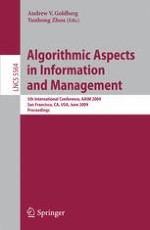2009 | Buch
Algorithmic Aspects in Information and Management
5th International Conference, AAIM 2009, San Francisco, CA, USA, June 15-17, 2009. Proceedings
herausgegeben von: Andrew V. Goldberg, Yunhong Zhou
Verlag: Springer Berlin Heidelberg
Buchreihe : Lecture Notes in Computer Science
